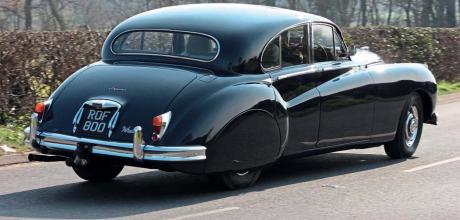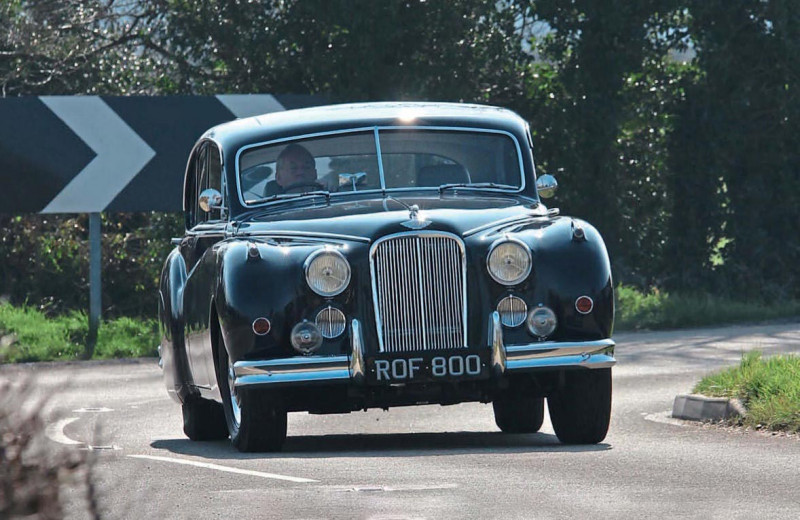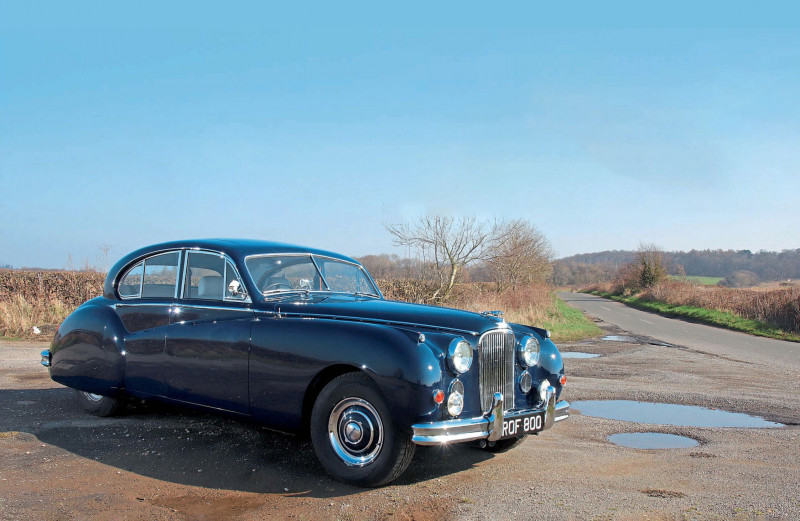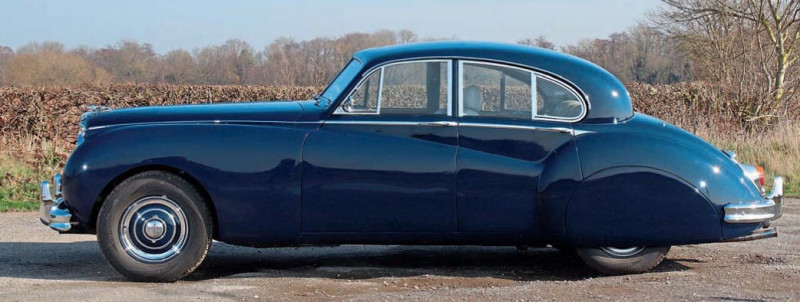190bhp 3.8-litre XK engined 1955 Jaguar Mk VIIM - perfectly upgraded for everyday use

In standard specification, a Jaguar Mk VIIM would require some degree of mechanical sympathy and patience to drive, but this one has several updates, so is it any better?
Overstepping the mark
Words & photography Rob Hawkins
Modified Mk VIIM Perfectly upgraded for everyday use
With its 3.8-litre engine, limitedslip diff’, Koni dampers, servo-assisted disc brakes and power-assisted steering, this Mk VIIM has been subtly upgraded to make it ideal for regular use
Have you switched over to the other fuel tank?" is the one question from Jaguar specialist Ken Jenkins that answers all my problems during the half-a-minute phone call I have with him whilst I'm sat in what I thought was a non-running Jaguar Mk VIIM. I almost feel my ears and teeth growing longer, along with the temptation to make a loud donkey-sounding ee-aw noise.

With twin tanks located in the boot of this Jaguar, I'd naively assumed the fuel would be drawn from both of them, but I should have spotted the dashboard-mounted switch labelled with the letters L and R. Flicking the switch to the other tank, followed by a twist of the ignition key results in the familiar sound of an electric pump ticking away, but this time there's fuel to ensure it stops ticking. A dab of the starter button sees the XK engine fire back into life and everyone breathes a sigh of relief. Perhaps I should be given a carrot.

Magazine test drives always have the potential for calamities because you can't be expected to be an expert in driving all cars, especially one that is heavily modified like the one seen here. I'd narrowly missed a couple of embarrassing disasters before I'd even started the engine, when I checked with Ken as to whether the clutch pedal should be depressed when firing up the XK. He explained I should leave my feet off the pedals to avoid dragging the clutch. And he thankfully made a passing comment about the overdrive switch, saying that it should never be switched off under heavy deceleration. He did however notice I hadn't locked the sunroof after I'd opened it and driven the car, explaining that it can slam shut if you brake too hard.

Some potentially embarrassing problems are not so easy to avoid, but on this occasion, I'm lucky, such as when a rabbit runs out in front of the Jaguar whilst I'm driving along the road leading to Ken Jenkins' workshop. Fortunately, I have enough time to stamp on the brake pedal and be grateful they have been uprated from drums to discs all round, allowing the rabbit to live for another day. Or perhaps more importantly at the time, for me not to have to explain to Ken why the offside front wing is dented along the bottom and covered in fur.
Before I'd even set eyes on this Mk VIIM, I was already preparing myself for a challenge, although not one I was dreading. The last time I'd driven such an old Jaguar was nearly three years ago when I spent a day with a 1947 Mk IV, which was powered by a 2,664cc overhead valve straight-six. Whilst such a model has pre-war styling and similarly dated components, including trafficators and drum brakes all round, this later Mk VIIM may be only eight years younger, but it’s worlds apart, especially with its updates. Those updates are hard to miss. Open the doors and not only has the original red upholstery been changed to a lighter cream leather, but the seats have too (the interior was trimmed by BAS International). The front seats are from a XJ6 Series 3 and the rear is out of a Mk IX. There are inertia reel seatbelts in the front and rear (two in the back), a feature that wouldn’t have originally been fitted back in 1955.
I take for granted the luxury and firm support of the modern seating until Ken remarks that a Mk VIII he has recently bought isn’t half as comfortable. Whilst the seating has been successfully modernised, the woodwork and instruments have thankfully been left alone, only the veneer having been protected in a coat or two of matt-finish varnish to reduce the risk of unwanted reflections. There’s a subtle set of push-button switches and vents in the lower half of the centre console that hardly hint at the fact that the interior can be filled with cold air if required by switching on the air-conditioning (a conversion kit from RetroAir in the US has been fitted).
Other modern traits include a Smiths clock mounted to the left of the centre console, which looks a little too modern for the Fifties, a very modern-looking Alpine stereo head unit in the centre of the dashboard (the CD changer is tucked away inside the boot) and a concealed USB charger port lurking underneath the upper half of the dashboard. I’m grateful for some of the updates, such as the small, orange-coloured light in front of the steering wheel that flashes when the indicator stalk switch is operated – although it’s an odd place to mount it and surely a buzzer would have been better?
The standard of refinement inside this Mk VIIM isn’t limited to its looks. On the road, there’s very little noise from the engine, tyres and suspension. Looking at the car’s history file and masses of receipts, this is because the interior has been soundproofed, including the inside of the roof (using 10mm thick closed cell foam) and even the underside of the bodyshell where the twin-silencer exhaust system is mounted. Soundproofing not only helps to keep unwanted noise from entering the cabin, it also reduces the risk of panel rattles, of which there are seemingly none in this case.
I don’t fully appreciate this level of refinement, especially the quietness of the engine until Ken is driving and he comments on how quiet it is. I do however appreciate that I now know how to get out of the car without looking stupid in front of Ken (again). On the inside of each door, there’s no separate and traditional release lever, just a window winder, grab handle and armrest.
Luckily, it only takes me a few seconds to find the release lever hidden inside the grab handle and avoid the embarrassment of winding down the window and opening the door using the exterior handle.
Several aspects of this Mk VIIM admittedly take me a little longer to get to grips with. The Moss four-speed manual gearbox is one of them. I’ve driven a few Jaguars with this ‘box, so I’m not completely green. The four forward gears are arranged in a H-pattern and in this case, there’s a long throw between them. I soon discover that I could easily think I’ve manoeuvred the gearstick far enough to engage a gear, only to hear the engine over-revving. Changing down from fourth or third to second gear takes a little practice because the lockout to prevent selecting reverse (positioned to the left of first) is quite weak. Consequently, it’s easy to move the gearstick too far across and find there’s no second gear.
The weak lockout for reverse is more of a problem when trying to select first gear and set off. It’s too easy to accidentally select reverse and head off backwards instead of forwards. A more relaxed approach to selecting first and not being so forceful with the gearstick is one solution to this potential problem, enabling me to feel the lockout. Another solution is to select second gear, then move the gearstick forwards for first.
I probably have too many opinions rattling around in the back of my mind as to how awkward the Moss four-speed ‘box can be, but after a few minutes of driving, I soon start to feel better acquainted with it, even the moderately heavy clutch pedal. And I’m no stranger to difficult gear selection, having owned a Lotus Europa and for the last 12 years, a Volkswagen Type 2 Transporter with a soup-stirring rod change.
My gear selection problems are partly masked by the forgiving nature of the engine, which means it can cater for many of my mistakes whereby I lose speed if I fail to swiftly move up a gear. Under the bonnet, the original 190bhp 3.4-litre XK engine (the M model had an uprated XK engine with an extra 30bhp) has been changed for a slightly larger 3.8 from a Mk IX, which has been rebuilt with several modifications to help preserve it and make routine maintenance easier. For instance, there’s an XJ6-spec oil pump and pick-up.
The rear main oil seal has been changed from a rope seal to a neoprene seal, which requires machining of the crankshaft. The crankshaft has been balanced, the flywheel lightened, and a heavy-duty clutch and competition-spec camshaft followers fitted.
One of the previous owners of this Mk VIIM, who had commissioned this XK engine to be rebuilt and installed back in 2008, had specified that it needed to be reliable and sufficiently torquey to withstand pulling a caravan over the Alps and into Italy – hence the tow bar at the rear and the aluminium radiator inside the engine bay. This also explains why the gearbox was rebuilt around the same time and the rear axle was overhauled and equipped with a GKN Powr-lok limited slip diff’, believed to be from an Aston Martin, and with what’s understood to be a 4.09:1 final drive ratio (originally, it would have been 4.29:1). The entire package of engine, gearbox and diff’ seems to cater for a wide range of demands. There’s sufficient pulling power to negotiate tight corners in third gear without the need to change down to second, and hard acceleration results in a long and entertaining power band. Hard to achieve with such a heavy car that according to Autocar’s road test report from 1952, weighs in at 34.75cwt or 1,765kg (unladen) with five gallons of petrol in the tank(s), but nearly two tons laden, which is perhaps closer to the mark on this Jaguar considering the additional soundproofing and accessories it has.
The heaviness of this Mk VIIM is hard to believe for a number of reasons when you are behind the wheel. The view ahead is very easy to get to grips with because the front corners are in view, meaning you quickly find the proportions of the car. Sadly, there’s not much chance of knowing what’s behind you. The dashboard-mounted rear-view mirror gives a glimpse of what might be another car or an obstacle when reversing. The side mirrors that are mounted to the doors are next to useless. Despite these misgivings, there’s a lot more all-round visibility if you simply look behind you, which is reassuring when parking or manoeuvring, but not advisable when on the move and about to overtake for instance.
There are other factors that help to belie the seemingly large size and weight of this Jaguar. The power-assisted steering is light and precise with very little play at the steering wheel, helping to improve the ease with which this car can be manoeuvred. The power steering pump is from a Jaguar Mk IX and is mounted on the rear of the alternator. The refinement of the suspension has a lot to contribute towards how light and nimble this Jaguar feels. With standard wishbones and torsion bars at the front, the anti-roll bar has been uprated with one from Harvey Bailey Engineering and Koni adjustable dampers have been added all round. At the rear, the standard semi-elliptic leaf springs have been overhauled.
The resulting handling and ride quality hasn’t eliminated any of the traditional characteristics of this suspension set u, but it does feel controllable. For example, there’s plenty of body roll under cornering, but thanks to the suspension, seating and seatbelts, you don’t feel as though you are hanging on to whatever you can grab hold of. Lumps in the road are adequately absorbed should one or more of the wheels run over them. Add in the aforementioned soundproofing and all of these improvements work together to create a superior ride quality.
The brakes also contribute to that ride quality, more so when it comes to slowing down and requiring the suspension to be compliant. The all-round disc brakes from a Mk IX were the starting point for replacing the standard drums, and at the front, Coopercraft four-pot calipers have been fitted. Plus, there’s a vacuum-operated servo and brake master cylinder from a Mk 2. The responsiveness of the brakes isn’t exactly pin-sharp and you need to stab the brake pedal hard with your right foot to make the Jaguar lurch. This is one aspect where the weight of the car is perhaps felt. Or maybe a different brake master cylinder would produce amore responsive feel. The seemingly large size of this Jaguar is deceptive. From the photographs and even in the flesh, it looks huge and cumbersome, yet its proportions of 16ft 4.5in long (almost five metres) and 6ft 1in wide (185.42cm), mean that it’s similar to the first-generation XF. I would have thought it is much bigger, but it’s not.
The history of this Mk VIIM shows that it has been a project long in the making. According to its Heritage certificate, it was manufactured on 7 March 1955, painted in a non-standard two-tone cream and red and the interior was upholstered in red. It’s believed that around 1968, the engine overheated, blew the head gasket and caused internal damage to at least one of the pistons. With around 45,000 miles on the clock, the then 13-year-old Jaguar may have seemed to be too old and too expensive to repair, but whatever the thinking, it didn’t return to the road and its owner and his wife had both passed away by 2003. The house where it was kept was sold to a builder who hauled it out from its semi-collapsed surroundings. The car was sold to a local Jaguar enthusiast, who sold it on to another enthusiast in 2004 for £3,500 who was keen to restore it.
The restoration appears to have started in around 2004 when Jaguar Daimler Heritage Trust and the Jaguar Enthusiasts’ Club were contacted to help apply for the car’s original registration. This was successfully completed and the restoration was underway. The then owner, Mark Hatton, recalls, “The body was unusual in that it had more rot on the top than on the bottom, as a result of the roof of the shed it was stored in collapsing. This necessitated the replacement of the roof with another roof from a car with the more usual sill and door rot. Whilst the replacement roof was off and upside down on the workshop floor, all the water channels from the sunroof could be repaired. All removable panels, including all four doors, front wings, boot etc were shot blasted and stove-enamelled before being repaired with new panels.”
Mark remembers that a new genuine Jaguar sill was found at an autojumble, new rear-wheel spats were fabricated out of aluminium to match the originals and the bodywork was resprayed by a professional who was unemployed at the time. “He worked on it every day, eight hours a day, for nearly four months,” he says. Having chosen to respray the exterior in a more modern-looking Indigo Blue, instead of two-tone red and cream, the results still look stunning.
The correspondence and receipts that accompany this Mk VIIM show that up to 2015, roughly £37,000 was spent on it, then a further £17k between 2015 and 2020. Mark estimates he invested some 3,500 hours of his own time in the project, not to mention all the help from specialists including BAS International and Ken Jenkins. The standard of finish and drivability of this Mk VIIM are astounding and by today’s prices, would be very difficult to re-create to such a budget, which helps to justify the car’s price tag of £75k. It may look large and cumbersome, but looks can be deceptive and the modern equipment that has been incorporated into this MK VIIM mean it can rub shoulders with a Mk 2 or an early XJ6 without being embarrassed.
Thanks to: Ken Jenkins Classic Jaguar Specialist (01909 733209/ukjag.co.uk)
Front seats are from a XJ6 Series 3. Dashboard and other interior wooden panels were coated in varnish, but didn’t need a thorough stripdown
BELOW: Bootlid is supported by a heavy-duty stay. Somewhere inside there’s a CD-multichanger
3.8-litre XK engine was taken from a Mk IX and rebuilt to help maximise its torque BELOW: Rear-wheel spat covers were custom-made from aluminium


Questionable expense. Just a brief missive to thank you for an excellent article; surely the best in the past 12 months? The Mk VIIM feature was of particular interest as an identical model was owned by a family friend in the early Sixties (when I was 11) and I would often sit behind the huge steering wheel and pretend to drive. It was in average condition and cost about £250. The modifications made to the car are very sensible but I have to question the expense. Great work.